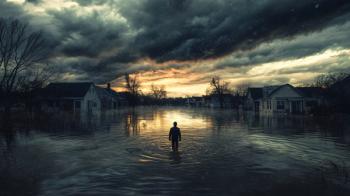
Is There Really an “Epidemic” of Psychiatric Illness in the US?
If claims in the non-professional media can be believed, there is a “raging epidemic of mental illness” in the US, if not world-wide-and, in one version of this narrative, psychiatric treatment itself is identified as the culprit.
Epidemic: (from epid?mos, prevalent : epi-, epi- + d?mos, people) "...an epidemic refers to an excessive occurrence of a disease."--from Friis & Sellers, Epidemiology for Public Health Practice, 4th ed, 2010
If claims in the non-professional media can be believed, there is a “raging epidemic of mental illness” in the US1, if not world-wide-and, in one version of this narrative, psychiatric treatment itself is identified as the culprit. There are several formulations of the “epidemic narrative,” depending on which of psychiatry’s critics is writing. In the most radical version, it is psychiatric medication that is fueling the supposed burgeoning of mental illness, particularly depression and schizophrenia.2 More subtle variants suggest that there is a “false epidemic” of some psychiatric disorders, driven by dramatically rising rates of “false positive” diagnoses.3
It is not my intention to examine each of these arguments in detail (for one useful debate, see reference 4). Nor am I primarily addressing the question, “Is there sometimes over-diagnosis, or over-treatment, of certain psychiatric conditions, such as ADHD or bipolar disorder?” (In brief, I believe there is both over- and under-diagnosis of most psychiatric disorders, depending on the clinician’s experience and the thoroughness of the evaluation). Rather, I want to address the claim that serious psychiatric illness is dramatically increasing in the US-not simply that it is being “over-diagnosed,” but that the number of genuinely “sick” individuals has skyrocketed in recent years. If we limit our analysis primarily to the adult population-the focus of my commentary-I believe the evidence for this claim is very thin. The matter becomes somewhat more complicated when we look at children and adolescents-but in that arena, the concept of the “false positive” must be carefully scrutinized, since the term is often misused or misunderstood.
Some who argue that actual psychiatric illness is on the rise in the US point to increasing rates of disability determinations-for example, increased numbers of those “disabled” by mental disorders who qualify for Supplemental Security Income (SSI) or Social Security Disability Insurance (SSDI). Thus, journalist Robert Whitaker uses such data to conclude that psychiatric disability rates are now around 6 times what they were in 1955.2 But SSI/SSDI determinations are unreliable measures of the actual incidence (new cases) or prevalence (basically, total cases at a given time) of psychiatric disorders. First of all, disability determinations by the Social Security Administration (SSA) are subject to a myriad of socioeconomic factors that have no direct bearing on how widespread a disorder is, in any given year. For example, many applicants for SSI/SSDI have already been turned down by their regular (private) disability insurer. These unfortunate individuals often present in desperate financial straits and may-quite understandably-come well-prepared to make their “case” to the evaluator (see, eg, the website
Nor can “disability determination rates” be equated with medically-determined disability. The initial SSA determination is made by a two-person adjudicative team consisting of a “medical or psychological consultant” and a “disability examiner.” (see
Other proponents of the “mental illness epidemic” narrative point to rising rates of antidepressant prescription in the US. Let’s be clear: this is no myth. Researchers Ramin Mojtabai and Mark Olfson found that the rate of antidepressant drug treatment in the US increased more than 4 times between early 1990s and early 2000s.5 Of special note, the rate of antidepressant treatment increased more in the group of less severely ill individuals than in those with more severe psychopathology. These findings are certainly cause for deep concern, and may reflect disturbing trends in the treatment of depressed patients-for example, the declining use and availability of psychotherapy among psychiatrists, and limited access to psychiatric physicians. However, rates of antidepressant prescription -largely prescribed by general physicians-cannot be used to compute or infer incidence or prevalence rates of depression. Indeed, many prescriptions for antidepressants written by non-psychiatrists are for the treatment of pain, insomnia, or other non-psychiatric conditions.6
That said, when we look at rates of diagnosis and treatment of bipolar disorder, particularly in younger patients, the statistics are quite sobering. Dr. Mojtabai’s group, for example, has found that the number of visits to a doctor's office that resulted in a diagnosis of bipolar disorder in children and adolescents has increased by 40 times over the last decade.7 Over the same time period, the number of visits by adults resulting in a bipolar disorder diagnosis almost doubled. But what do these figures really mean? For one thing, the survey examined the number of office visits, not the number of individual patients, so some patients may have been counted more than once. Also, it is not clear what diagnostic criteria the treating physicians used, or how closely the doctors adhered to the “official” criteria for bipolar disorder, used in the Diagnostic and Statistical Manual of Mental Disorders (DSM-IV). Indeed, as then NIMH Director, Thomas R. Insel MD, observed in 2007, “We do not know how much of this increase reflects earlier under-diagnosis, current over-diagnosis, possibly a true increase in prevalence of this illness, or some combination of these factors.” 8
The issue of “over-diagnosis” brings us to the thorny problem of the “false positive” in psychiatry. Some critics are fond of arguing that rates of bipolar disorder, major depression, and other psychiatric conditions are being inflated by “false positives.” For example, they argue that children who are merely “temperamental” are being falsely diagnosed as having bipolar disorder; or that “bored” and overactive children are being misdiagnosed as having ADHD. There may be some validity to these claims, in certain clinical settings-but the claims themselves must be carefully scrutinized, with respect to the notion of a “false positive.” In general medicine, the term “false positive” usually entails 2 requirements: first, the existence of a reliable and valid set of diagnostic criteria; and second, the availability of a definitive confirmatory test. The definitive test for syphilis, for example, depends on the direct or indirect identification of the causative organism in the blood or cerebrospinal fluid. It is a truism that, at present, the field of psychiatry does not have such “lab tests” for its principle diagnoses, and even the criteria for these conditions are in a state of flux. When critics of psychiatry argue that there are too many “false positives” for a particular diagnosis, what they usually mean is that, in their considered opinion, too many patients are being diagnosed with the condition; or that there is excessive “medicalization” of “normal problems in living.”3 These are certainly arguments worthy of debate-but in no way do they constitute scientific proof of increasing “false positives” in psychiatric diagnosis. Rather, these claims are vestiges of the Platonic notion that in our diagnostic criteria, we are fully capable of “carving Nature at its joints.” But the nature of human disease often eludes such precise articulations. Much depends on the degree of suffering and incapacity we, as a society, choose to consider “normal” or “disordered”-and ultimately, this is an existential decision, not an objective determination.9
With respect to the incidence and prevalence of (unipolar) depression among adults, the best epidemiological studies do not support the “epidemic” narrative. For example, a study of the Baltimore, Maryland catchment area between 1981 and 2004 was recently carried out.10 Participants were selected from the household population in 1981, and interviewed in 1981, 1993, and 2004. Diagnoses were made via the Diagnostic Interview Schedule according to successive editions of the DSM-III and IV. There was indeed a rise in the prevalence of depression in the prior quarter century among 1 subgroup: middle-aged females. However, overall depression incidence rates (new cases) in the period 1993-2004 were actually lower than the period 1981-1993, suggesting that the rise in prevalence is due to increasing chronicity. In other words, previously depressed patients were continuing to be depressed-there was no evidence of an “epidemic” or “surge” of new cases of depression. (It’s important to point out that, in principle, rising or “accumulating” prevalence of an illness may drive up treatment and/or disability determination rates, without signaling an increase in “new cases” or incidence of the condition).
Similarly, most epidemiological evidence gathered since the beginning of the neuroleptic era (ca. 1954) does not support the claim that schizophrenia is significantly increasing in incidence or prevalence, either world-wide or in the US.11 To be sure, rates of schizophrenia vary considerably from country to country, and from rural to urban settings (eg, showing increased incidence in South London from 1965-1997 12,13). Rates of schizophrenia are also critically dependent on methods of detection; eg the use of lay interviewers versus clinicians, and the use of open versus structured clinical interviews. Nonetheless, a recent study of the incidence of schizophrenia and other psychoses in England, 1950-2009, found essentially “no evidence to support an overall change in the incidence of psychotic disorder over time, though diagnostic shifts (away from schizophrenia) were reported.”14 Since antipsychotic medications have been used for decades in the UK, this finding argues strongly against the notion that these drugs are markedly increasing new cases of schizophrenia.
Dr. Peter Buckley, an international expert in the area of schizophrenia, wrote in an email that “There is no evidence of a shift in incidence or prevalence discernible over recent years” with respect to rates of schizophrenia (personal communication, 4/30/12). Consistent with this view, a study by Cowan et al15 evaluated patterns of initial hospitalizations for schizophrenic disorders among US military personnel for 2000-2009, and found “no consistent changes in rates over time.”
Another useful way of assessing claims of an “epidemic” of psychiatric illness is to examine measures of psychological “distress” in the general population, as a function of time. The Substance Abuse and Mental Health Services Administration (SAMHSA) of the US Department of Health and Human Services recently reported on a measure they call “serious psychological distress” (SPD).16 SPD does not represent a specific psychiatric diagnosis; rather, it measures the presence of mental health symptoms that may negatively affect a person’s ability to participate in family, community, and work life. SPD is measured by a symptom scale designed to assess psychological distress within the past 30 days. The most recent report from SAMSHA, Mental Health, United States, 2010, reached an important conclusion; namely, that “National levels of psychological distress in adults have remained relatively stable for more than a decade.”[
The report also assessed another dimension of psychiatric impairment called “serious mental illness” (SMI). This is defined by both symptoms and their resulting serious functional impairment in the past year. According to the SAMHSA report, approximately 11 million US adults had serious mental illness, representing 4.6% of the population. There is no credible evidence to suggest that this represents a dramatic increase from previous determinations of SMI. For example, the 2001 National Household Survey on Drug Abuse (NHSDA) estimated that about 15 million adults aged 18 or older-7 % of the US population-experienced SMI during the past year.17 While the SAMHSA and NHSDA studies used somewhat different methods of calculating the SMI rate, the estimates from 2001 to 2009 do not point to a burgeoning increase in serious mental illness in the US.
Furthermore-and contrary to some widely-publicized claims1-there is little evidence showing a dramatic increase in mental health treatment in the US. The most recent SAMHSA report actually found that “. . . since 2002, adult use of outpatient mental health treatment has declined slightly, while inpatient treatment use has remained stable.”16 While this finding is not unalloyed “good news”-after all, there is evidence of significant under-treatment of serious mental illness in the US.18-it hardly supports the claim that this country is witnessing a new “epidemic” of mental illness. Nor does it support the hypothesis that psychiatric treatments, including medication, are fueling an “epidemic” of serious psychiatric illness. If this were the case-and even allowing for more restrictive admission policies--we should be seeing a “signal” in substantially rising rates of psychiatric hospitalization.
Conclusion
In sum, there is little credible evidence that the US is experiencing a huge spike in serious psychiatric illness, at least among adults. This does not mean that psychiatrists should be complacent regarding markedly increased rates of diagnosis-for example, of ADHD or autism-nor should we minimize the potential side effects of psychiatric medication. But while carefully attending to these issues, we should not lose sight of the bigger picture. Uninformed fear-mongering about an “epidemic of mental illness” only distracts us from the sad reality of mental health care in the US-namely, that tens of millions of uninsured or impoverished individuals are unable to avail themselves of the best available psychiatric treatments.17,19 Now that is an “epidemic” worth worrying about.
Acknowledgments: I would like to thank my colleagues, Drs. Peter Buckley, William Glazer, David Cowan, Steven Moffic, James Knoll, and Nassir Ghaemi for reading and/or commenting on earlier drafts of this piece, or for providing perspective on the matters discussed.
References:
1. Cf. Dr. Marcia Angell: “It seems that Americans are in the midst of a raging epidemic of mental illness, at least as judged by the increase in the numbers treated for it.” Angell M: The Epidemic of Mental Illness: Why? The New York Review of Books. June 23, 2011.
2. Whitaker R. Psychiatric drugs and the astonishing rise of mental illness in America. Ethical Human Psychology and Psychiatry. 2005;7:23-35.
3. Horwitz AV, Wakefield JC. The Loss of Sadness. New York, Oxford University Press, 2007.
4. Gotbaum R. Are psychiatric medications causing more mental illness? Radio Boston. Jan 19, 201. Accessed at:
5. Mojtabai R, Olfson M. National trends in psychotherapy by office-based psychiatrists. Arch Gen Psychiatry. 2008;65:962-970
6. Mojtabai R, Olfson M. Proportion of antidepressants prescribed without a psychiatric diagnosis is growing. Health Affairs. 2011; 30:1434-1442.
7. Moreno C, Laje G, Blanco C, et al. National trends in the outpatient diagnosis and treatment of bipolar disorder in youth. Arch Gen Psychiatry. 2007;64:1032-1039.
8. National Institute of Mental Health. Rates of bipolar diagnosis in youth rapidly climbing, treatment patterns similar to adults. Press Release; September 03, 2007
9. Pies R. Toward a concept of instrumental validity: implications for psychiatric diagnosis. Dialogues in Philosophy, Mental and Neuro Sciences.
10. Eaton WW, Kalaydjian A, Scharfstein DO, et al. Prevalence and incidence of depressive disorder: the Baltimore ECA follow-up, 1981-2004. Acta Psychiatr Scand. 2007;116:182-188.
11. Murray R. The Epidemiology of Schizophrenia. Cambridge University Press, 2003.
12. Boydell J, Van Os J, Lambri M, et al. Incidence of schizophrenia in south-east London between 1965 and 1997. Br J Psychiatry. 2003;182:45-49.
13. Stilo SA, Murray RM. The epidemiology of schizophrenia: replacing dogma with knowledge. Dialogues Clin Neurosci. 2010;12:305-315.
14. Kirkbride JB, Errazuriz A, Croudace TJ, et al. Incidence of schizophrenia and other psychoses in England, 1950-2009: a systematic review and meta-analyses. PLoS One. 2012;7(3):e31660. Epub 2012 Mar 22
15. Cowan DN, Weber NS, Fisher JA, et al. Incidence of adult onset schizophrenic disorders in the US military: patterns by sex, race and age. Schizophr Res. 2011;127:235-240. Epub 2011 Jan 11.
16. Substance Abuse and Mental Health Services Administration. (2012). Mental Health, United States, 2010. HHS Publication No. (SMA) 12-4681. Rockville, MD: Substance Abuse and Mental Health Services Administration.
17. National Household Survey on Drug Abuse. Oct. 18, 2002.
18. Gonzlez HM, Vega WA, Williams DR, et al. Depression care in the United States: too little for too few. Arch Gen Psychiatry. 2010;67:37-46.
19. Pies R. Antidepressants work, sort of-our system of care does not. J Clin Psychopharmacol. 2010;30:101-104.
Newsletter
Receive trusted psychiatric news, expert analysis, and clinical insights — subscribe today to support your practice and your patients.

















